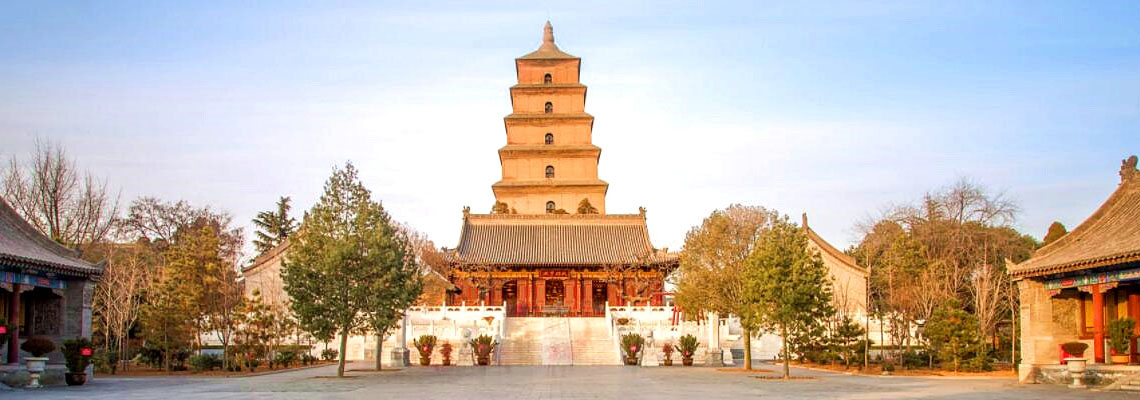
Day 1
Xi'anWe will meet you at the airport, transfer you to the hotel and check you in. The following day we will begin the tour. (Please note that if your international flight is to Beijing, you can take the flight to Luoyang, and start the tour from Luoyang.)
Day 2
Xi'an-
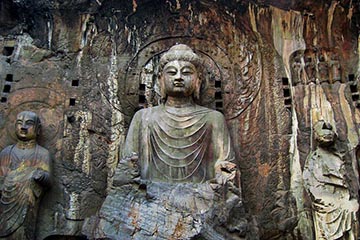
- The Longmen Grottoes
In the morning, we will take the highspeed train to Luoyang to visit the Longmen Grottoes, the White Horse temple and the Shaolin temple. After that we will take the highspeed train back to Xi'an.
The Longmen Grottoes: Located near Luoyang, Henan Province, the Longmen Grottoes is a treasure house of ancient Buddhist cave art. The grottoes were hewed and carved during the Northern Wei Dynasty (386-534), when the rulers relocated their capital at Luoyang near the end of the 5th century. At that time Buddhism was spreaded into east China and was venerated by the imperial court. The Buddhists adopted the practice of carving rock temples, dedicated to the Buddha.
White Horse Temple: White Horse Temple, or White Horse Ministry, was the first Buddhist temple in China, established under the patronage of Emperor Ming in the Eastern Han capital Luoyang in the year 68. White Horse Temple is one of the oldest buddhist temples. It is only 12 kilometers from Luoyang city.
Shaolin Temple: This famous temple is located in the region of Song Mountain, Dengfeng City, Henan Province. Throughout its history it has been reputed to be 'the Number One Temple under Heaven'. Included in UNESCO's World Cultural & Natural Heritage List in 2010, the temple is the cradle of the Chinese Zen Buddhism and the Shaolin Martial Arts such as Shaolin Cudgel.
Day 3
Xi'an-
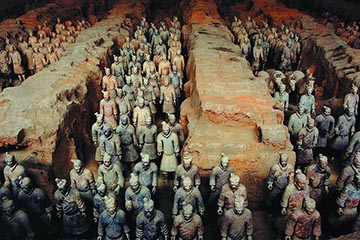
- Terracotta Warriors
After breakfast we will visit the Terracotta Warriors, the Big Wild Goose Temple and Xinjiao Temple. And then we will take the train to Tianshui, and check into the hotel.
Terracotta Warriors: This is one of the greatest archaeological findings of the 20th century - the army of terra-cotta warriors and the bronze chariots entombed in vast underground vaults at emperor Qin Shi Huang's tomb from two thousand years ago. It is a sight should not be missed by any visitors to China. Emperor Qin Shi Huang ascended to the throne of Qin at the age of 13 in 246 BC. Under him, Qin conquered the other six warring states and became the first true emperor, or Shi Huang, of China.
Big Wild Goose Pagoda: The Big Goose Pagoda is where the renowned Buddhist Master Xuanzang (Monk Tripitaka) stored his classics brought back all the way from India. The pagoda is one of the oldest structures in China. Originally it consisted of a brick structure of five storeys and was about 60 meters high. It was first built in 589AD during the Sui Dynasty. Between 701AD and 704AD during the reign of the Empress Wu Zetian five more storeys were added to the pagoda making it ten in all.
Xingjiao Temple: Xingjiao Temple is located about 20 km south of Xi'an, where Master Xuan Zang was buried. After the death of Master Xuan Zang in 644 AD, the body was carried back to Chang'an (Xi’an today) and then buried in the Bailuyuan (White Deer Prairie) in the eastern outskirts of Xi'an. In 669 AD, Emperor Gaozong of the Tang Dynasty issued an imperial edict to transfer Master Xuan Zang's body back to the Shaoling Prairie to the south of Chang'an.
Day 4
Tianshui-
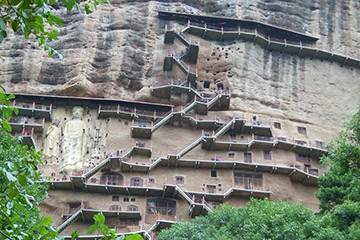
- Maiji Mountain
After breakfast we will visit Maijishan Grottoes, and Fuxi Temple, and then drive to Lanzhou.
Maiji Mountain Grottoes: Maiji Mountain is 150 meters tall, and it was named for its shape -- like that of a pile of wheat. According to historical records, the Maiji Grottoes were excavated during the Hou Qin Dynasty of the Sixteen Kingdom Period. The Maiji Mountain Grottoes have a long history. Excavation and rock carving continued for more than a thousand year. During the Beizhou Dynasty, Liyunxin built the Seven-Buddha Pavilion in memory of his deceased father. Emperor Wen Di of the Sui Dynasty ordered the construction of a Buddhist nun site. The present dagoba on the top of the mountain was rebuilt in the Qing Dynasty.
Fuxi Temple: Fuxi Temple is also known as Taihao Palace, as well as Renzhong Temple. After the ninth renovation and expansion in Emperor Guangxu's reign during the Qing Dynasty, it covered an area of 13,000 square meters. But what remains today only covers about 6600 square meters. Fuxi Temple has numerous courts and four compounds. Ten historic buildings in the temple include the theatrical stage, archways, the main gate, the instrumental gate, Congenital Temple, Taiji Temple, Bell Tower, Drum Tower, and Laihe Hall.
Day 5
Lanzhou-
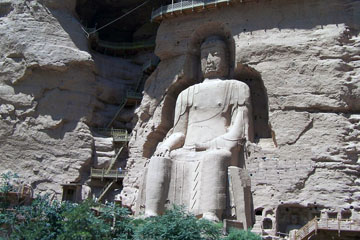
- Binglingsi Grottoes Buddha Caves
After breakfast we will head to the Bingling Thousand-Buddha Caves, after which we will drive to Wuwei.
Bingling Thousand-Buddha Caves: The Bingling Thousand Buddha Caves are on the cliff of Xiaojishi Hill. Located on a branch of Gansu part of the Silk Road, the Bingling Caves were started by Buddhist monks from as early as the West Jin Dynasty (265AD -316AD) although the official carving began in 420AD. Today there are 183 caves existing with 694 stone statues, 82 earth statues and murals of 900 square meters (9,688 square feet). Another pleasant surprise on your way to Bingling Caves is the beautiful Liujiaxia Reservoir. The crystal water lying among the yellow earth mountains is quite a sight. At the end of the Reservoir, the green water connects to the yellow water while the blue sky connects to the yellow earth. Perhaps this can only be experienced in Liujiaxia.
Day 6
Wuwei-
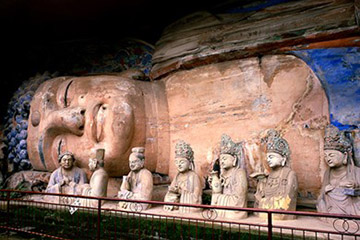
- Giant Buddha Temple
In the morning we will head to Jiayuguan ,and we will visit Giant Buddha Temple in Zhangye on the way.
Giant Buddha Temple: The historic city of Zhangye lies in the Midway of Hexi Corridor along the Silk Road , the centerpiece of which is the mysterious Giant Buddha Temple. Located in the southwest corner of Zhangye in Gansu Province, the Giant Buddha Temple is the largest architectural relic in Gansu Province of the Western Xia (1038-1227) period. China's largest reclining Buddha is well preserved in this temple. Zhangye Museum is also located here. There is a legend about Giant Buddha Temple that a chancellor named Wei Mie of the Western Xia period told workers to dig 1 to 1.3 meters deep to carve a reclining Buddha, and cover it with glazed color tiles. The Giant Buddha Temple was built in 1098 to house the Buddha. During the past 900 years, the temple was restored many times during the Ming and Qing dynasties.
Day 7
Jiayuguan-
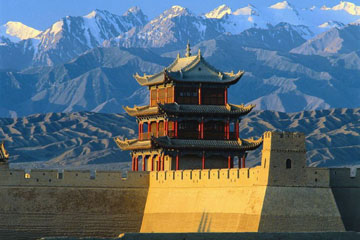
- The Jiayuguan Pass
In the morning we will visit The Jiayuguan Pass, The Great Wall on the Cliff, then we will proceed to Dunhuang.
Jiayuguan Pass: Jiayuguan Pass stands in the southwest part of Jiayuguan City, about 6 km away from downtown. Construction of the castle was started in 1372 in the Ming Dynasty, and is located in the Jiayu Highland, hence its name Jiayuguan Pass. It is situated between the Wenshu and Heishan Mountains at the foot of Jiayuguan Hill of the Qilian Mountain range.
The Great Wall on the Cliff: The Suspended Wall is a part of the Great Wall of China. The wall here was built on the ridge with a gradient of 45 degrees. It is high in the air and it looks as if it fell down from the top of the hill. So people refer to this section of the Great Wall as the "Suspended Wall". The Suspended Wall, the extension of the walls at the Jiayuguan Pass towards the north, was an integral part of the ancient defense system at the Jiayuguan Pass.
Day 8
Dunhuang-
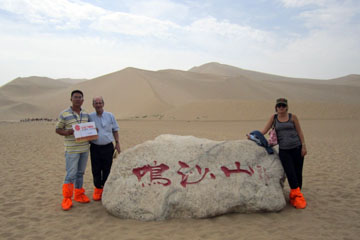
- Echoing-Sand Mountain
After breakfast we will visit the Mogao Grottoes, Echoing-Sand Mountain and Crescent Lake. You will then be transferred to the railway station to catch the train to Turpan.
Mogao Grottoes: The Mogao Grottoes, a shrine of Buddhist art treasures, is 25 km from downtown Dunhuang on the eastern slope of Mingsha Shan (Echoing Sand Mountain). A network of plank-reinforced roads plying north to south 1600 meters long lead to the cave openings, which are stacked five stories high, some reaching up to 50 meters. Incidentally, Mogao means high up in the desert. According to Tang Dynasty records, a monk had witnessed onsite a vision of thousand Buddhas under showers of golden rays. Thus inspired, he started the caves construction work that spanned a millennium, from the 4th to the 14th centuries. What remains today is truly awe inspiring, and is likely the world’s richest treasure house of Buddhist sutras, murals and sculptures. Please note that cameras are not allowed inside the grottoes.
Echoing-Sand Mountain and Crescent Lake: Together with the Crescent Spring and the Mogao Caves, the Echoing-Sand Mountain is the most popular tourist site in Dunhuang. Echoing-Sand Mountain, known as Mingsha Mountain to the Chinese, is 5 km to the south of Dunhuang and is famous for the constant sound of the moving sand. Legend has it that many years ago a horrific battle was fought here, and the sounds we hear today were the haunting cries of soldiers buried in the sand dunes. Situated within the Echoing-Sand Mountain Park, the Crescent Moon Lake is literally an oasis in the desert. The lake’s name derives from the crescent moon shape taken by the pool of spring water between two large sand dunes. Although the surrounding area is very dry, the pool surprisingly doesn’t dry up as one might expect.
Day 9
Turpan-
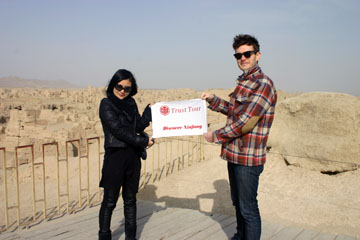
- Jiaohe Ruins
After checking in at the hotel, we will visit Jiaohe Ancient City, Astana Tombs, Tuyoq Valley and The Flaming Mountain.
Jiaohe Ancient City Ruins: The city's name means 'River City'. It was founded during the first century BC and abandoned during the 15th century. It is located atop a steep cliff on a leaf-shaped plateau between two deep river valleys in the Yarnaz valley 10 km to the west of Turpan City. It runs northwest to southeast, 1760 meters long and 300 meters across at the widest part. The ruins include city gates, streets and lanes, government office, temples, domestic houses, cave houses, wells, and an underground temple. It is part of the UNESCO World Heritage Silk Road Sites.
Astana Tombs: This is the graveyard of the residents who lived in the Gaochang City in the Jin-Tang period. Between 1959 and 1975, a great number of cultural relics had been unearthed, including Chinese documents, textiles, epitaphs, coins, clay sculptures, pottery, wooden wares, silk-paintings, crops and foods, etc. The site is known as the Underground Museum.
Tuyoq Valley: This is a 12 km long primitive Uighur agricultural valley about 70 km from Turpan, with vineyards and fields in the northern and southern valleys and a narrow ravine that connects them. It is a Muslim religious pilgrimage site. The southern mouth of the valley has big Uighur mosques older than the Sugong Minaret and a cave thought by many to be described in the Koran. About a kilometer from the cave shrine is a group of grottoes that have some Buddhist and Nestorian artwork. These grottoes are said to date from the West Jin Dynasty (265AD-316AD), and are considered to be the earliest in Turpan. Most of the murals are damaged. Fortunately, 10 of the grottoes still have some of the preserved murals. These precious murals are very unique in style.
The Flaming Mountain: The Flaming Mountain is famously described in the classic Chinese mythological novel “Journey to the West”. It runs west from Shanshan County, is 98 km in length and 9 km across, with a relative height of 500 meters and the highest peak at 832 meters. The mountain is a branch range of the Bogda Mountain, formed in the orogenic movements of the Himalayas. This is the hottest place in China. The highest air temperature in summer is 47.8 degrees Centigrade, and the ground is over 70 degrees Centigrade in summer. Many years of volcanic activity have formed the unique crisscrossing gullies and ravines. During mid-afternoon the heat becomes intense as the sun's rays are reflected off the red rocks, as though the hillsides are engulfed by tongues of fire, hence the name.
Day 10
Turpan-
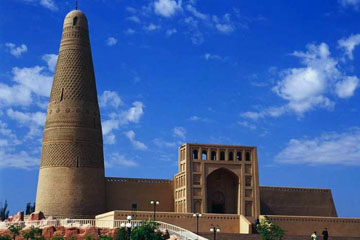
- Sugong Minerat
After breakfast we will visit the Karez Irrigation System, Sugong Minaret. After that we will return to Urumqi to take the flight to Kashgar. We will check into the hotel upon arrival in Kashgar.
Karez Irrigation System: The ancient Karez Irrigation System, which is still used today, is a unique irrigation system in Turpan. It takes advantage of the slopes, draws the underground water to flow by itself to irrigate farmland. It consists of four parts: vertical wells, underground channels, ground canals, and small reservoirs.
Sugong Minaret: Located in Mura Village 2km to the east of the city of Turpan, the minaret tower was built in the 41st year of the long reign of Qianlong Emperor during the Qing Dynasty. It is the embodiment of the ancient architectural arts of the Uighur people. The body of the tower is cylindroid in shape, built with bricks arranged in various symmetrical patterns on the outer wall. The tower has 14 windows and a spiral staircase inside going to the top.
Day 11
Kashgar-
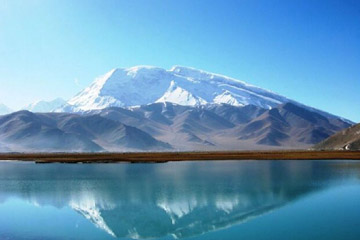
- Karakul Lake
After breakfast we will visit the Sunday Bazaar, then head to Karakul Lake to enjoy the beautiful scenary.
Sunday Bazaar: This is called “Sunday” bazaar but it is open daily, even though it is busiest on Sundays. Streets near this big market are jammed with farmers and buyers arriving by donkey cart, truck, bicycle, horseback, ute, motobike, or on foot, with their animals. It is loud, lively and cheerful as they arrive, eat breakfast, set up their animals and check out the action. Cattle, sheep (they definitely look different), goats, donkeys, horses have their own sections. Sellers show off their animals as “good eaters” (most go as livestock, not meat). The entire experience is fascinating and fun.
Karakul Lake: At an altitude of 3600m, this is the highest lake of the Pamir plateau, near the junction of the Pamir, Tianshan (Heavenly Mountain), and Kunlun Mountain ranges. Surrounded by mountains which remain snow-covered throughout the year, the three highest peaks visible from the lake are the Muztag Ata (7546m), Konur Tagh (7649m) and Kongur Tiube (7530m). The lake is popular among travelers for its beautiful scenery and the clarity of its reflection in the water, whose color ranges from a dark green to azure and light blue. There are two Kirgiz settlements along the shore of Karakul Lake, a number of yurts about 1 km east of the bus drop-off point and a village with stone houses located on the western shores.
Day 12
Kashgar-
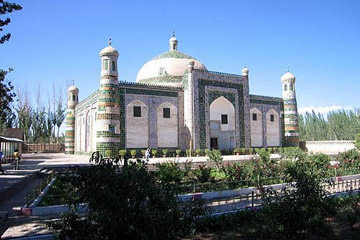
- Apak Hoja Tomb
In the morning we will visit the Id Kah Mosque, the Apak Hoja Tomb, Handicraft street and Old Town. After that we will send you to the airport to take the flight to Chengdu
Id Kah Mosque: This is the largest mosque in China, and the most famous mosque in Xinjiang. The construction of the mosque started in the middle of the 15th century, and the mosque has gradually developed to its present size. The buildings of Id Kah Mosque look magnificent and solemn, and display the artistic styles of Islamic mosque architecture. The Mosque has an area of about 16,800 square meters, consisting of the Pray Hall, the Koran teaching Hall, the Corridor, the Arches and other buildings attaching to it. The Pray Hall of the mosque, which can hold 4,000 prayers, is supported by 140 carved wooden pillars.
Apakh Hoja Tomb: This Mazar is the holiest place in Xinjiang for the Muslims, and an architectural treasure. Built in 1640, it is reminiscent of the Central Asian artistic style of Samarkand or Isfahan. The site is also known as the Xiang Fei (Fragrant Concubine) Tomb in memory of Abakh Khoja's granddaughter, Iparhan, who was the Fragrant Concubine of Emperor Qianlong of Qing Dynasty. A handsome blue-and-white tiled gate leads into the compound, which includes a small religious school and the Abakh Khoja family tomb. The latter is domed and faced with muti-color tiles. It is the most complete Islamic tomb dating from the beginning of the Qing Dynasty.
Handicraft Street: Handicraft Street, or Zhiren Street, is a fascinating place showing the distinctive custom and culture of Kashgar, with many full-time handicraftsmen working on the street and hundreds of workshops and booths alongside. This street is an exhibition for traditional Kashgar and mid-Asian handicrafts. Copper, metal, porcelain, woodwork, jewellery and other goods are seen to be made here and you will marvel at the incredible devices like the wooden objects that prevent babies from wetting the bed.
Old Town: Kashgar is an ancient city, and in walking the streets of its Old Town, one gets the sense of what this legendary Central Asian hub was like in the days when the Silk Road was at its zenith. 500-year old remnants of the city wall, narrow lanes and colorful multi-ethnic crowds combine to make Kashgar’s historic district a highlight of any visit to the city. Visit the small alleys to look at the characteristic Uygur residences. You will experience and enjoy the culture and history that has been retained in the small alleys and deep courtyards. In the alleys on platforms beside the residence you could marvel at the even more ancient primitive workshops for hand-made earthenware. Some 17 or 18 antique workshops have been restored.
Day 13
Chengdu-
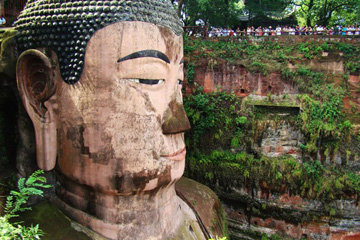
- Leshan Buddha Sculpture
Today we will take the Chengdu Tour to Kuanzai Lane, and then visit the Leshan Buddha.
Leshan Buddha Sculpture: The Giant Buddha (Dafo in Chinese) of Leshan is the tallest stone Buddha statue in the world, carved out of a cliff face by an 8th-century monk in southern Szechuan province. The Giant Buddha overlooks the confluence of the Minjiang, Dadu and Qingyi rivers and faces the sacred Mount Emei (with which it shares its World Heritage status). Construction on the Giant Buddha began in 713 AD. It was the idea of a Chinese monk named Haitong, who hoped that the Buddha would calm the turbulent waters that plagued the shipping vessels traveling down the river. His plans were not just supernatural, as it turned out. What had happened was that the enormous amount of rubble carved away from the cliff would be deposited in the river, actually altering the currents and calming the waters.
Day 14
Chengdu-

- Panda Reserve
Today we will visit the Panda Reserve. After that we will transfer you to the airport for you flight.
Panda Reserve: This is the Giant Panda Breeding and Research Centre - Zoos, scientific research centers, breeding centers, or semi-protected areas work together to maintain a self-sustaining population of a given species. This population may serve as a hedge against extinction of the species, as well as a reservoir for improved understanding of its natural history. The Chengdu Panda Base is an example of a scientific institute engaged in research towards conservation. The goal is not only to provide technical support for scientific research on wild pandas, but also to increase the wild population through improved management and, ultimately reintroduction of individuals into areas from which the populations have declined. Research at the Chengdu Panda Base focuses on the advancement of wildlife conservation in China.
| Travel in party of |
Superior Class ★★★★★ |
Deluxe Class ★★★★ |
Tourist Class ★★★ |
| 2-5 persons | N | $ | $ |
| 6-9 persons | N | $ | $ |
| 10 persons & above | N | $ | $ |
| Single room Supplement | N | $ | $ |
Service included:
√ Half board meals ( Breakfast + Lunch)3 Personal Guide & Driver + Private car / van for Private Transfers & sightseeing
√ Hotels with breakfast(twin share bases) as listed in the itinerary .
√ Domestic flights or trains as listed in the itinerary
(Xi'an to Luoyang express train return. Xi'an to Tianshui, Dunhuang to Turpan: Soft sleeper train)
Flights: Urumqi to Kashgar Return. Urumqi to Chengdu
√ Airport Taxes: US$30for domestic,
√ Service Charge & Government Taxes .
√ Luggage Transfers between airports and hotels
√ Goverment letter for visa support
Service excluded:
* Personal expenses, tips to the guide and driver.
* 3 Some activities such as boat cruise, camel riding, ect

